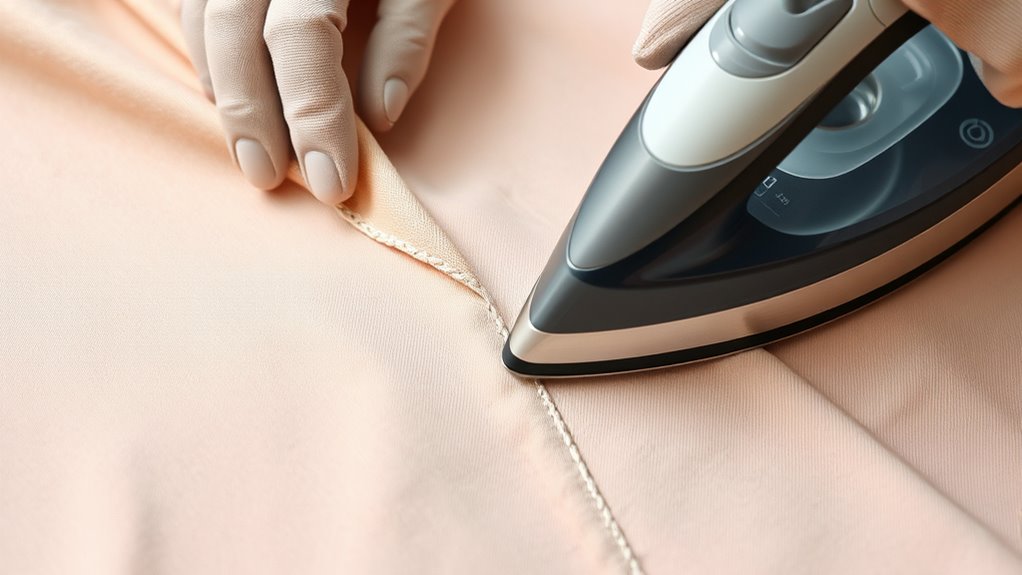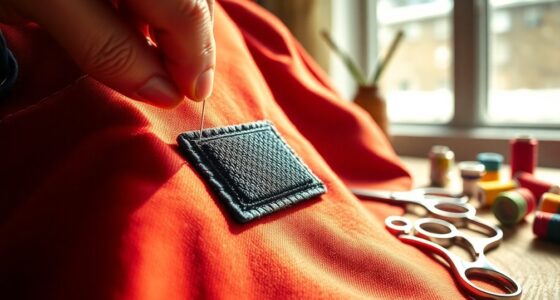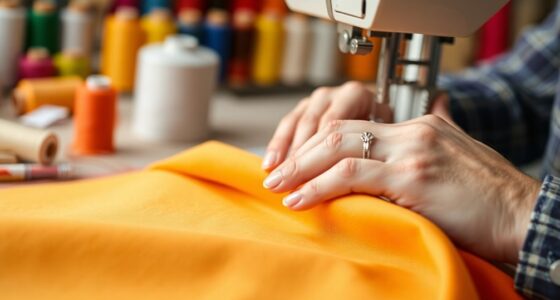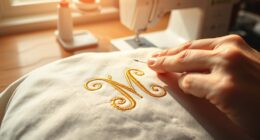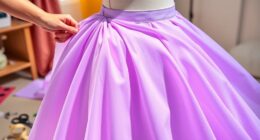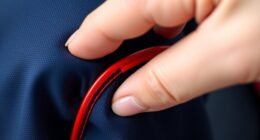To sew and press darts for a great fit, start by precisely marking the dart lines using tailor’s chalk or fabric markers, ensuring symmetry. Sew from the widest part toward the dart point for smooth shaping, then press the darts to lock in the shape, pressing allowances toward the center or side as instructed. Mastering proper dart placement, sewing technique, and pressing will help your garments fit better and look professional—more tips await if you continue exploring this essential skill.
Key Takeaways
- Mark darts precisely on the fabric using tailor’s chalk or fabric markers before sewing.
- Sew darts from the widest part toward the dart point for smooth, professional results.
- Press darts immediately after sewing, pressing allowances toward the center or side as instructed.
- Pin darts correctly, starting from the widest part, to ensure accurate sewing and shape.
- Consider fabric type and garment style when manipulating and pressing darts for optimal fit.
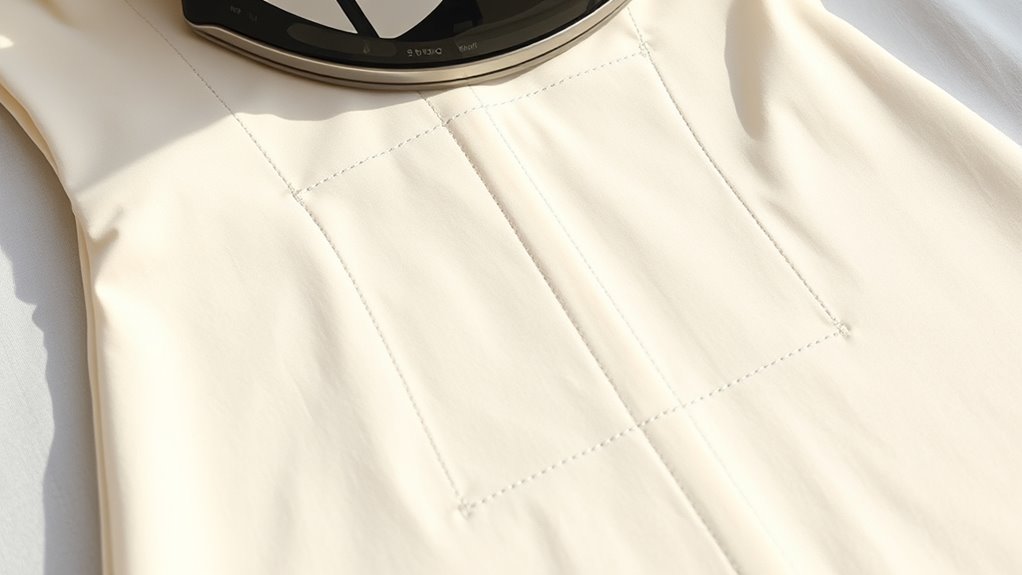
Have you ever wondered what makes darts such a popular game worldwide? It’s not just about aiming and throwing; it’s about precision, control, and skill. When it comes to sewing, understanding darts is equally about precision—specifically, dart placement and dart manipulation. These techniques help you create garments that fit perfectly and look professional. Getting comfortable with how and where you place your darts can dramatically improve your sewing projects and guarantee a smooth, flattering fit.
Mastering dart placement and manipulation ensures perfect fit and professional finish in sewing projects.
Dart placement is vital because it determines how the fabric contours to the body. You want to position your darts in areas that naturally curve, like the bust, waist, or hips. Proper placement involves carefully marking where the darts will go, ensuring symmetry on both sides of the garment. You’ll want to measure accurately and use markers or tailor’s chalk to outline the dart lines. Proper dart placement not only enhances the fit but also contributes to the overall aesthetic by creating smooth, clean lines. When placing darts, consider the body’s shape and the style of the garment; a well-placed dart can make a simple shirt look tailored and sophisticated.
Once you’ve marked the darts, dart manipulation becomes your next focus. Dart manipulation involves how you sew and shape the darts to achieve a desired fit or style. For example, you might want to fold a dart towards the center or away from a seam to add interest or reduce bulk. You can also convert darts into other design elements, like princess seams or gathers, by manipulating their placement during sewing. When sewing darts, it’s essential to pin them correctly, starting from the widest part and tapering to the point, to ensure the fabric lays smoothly. Pressing the darts properly afterward is equally important—press the dart allowances toward the center or the side, depending on your pattern instructions. This step locks the dart shape in place and helps the fabric fall neatly. Additionally, understanding the fabric type you are working with can influence how you sew and press your darts for optimal results.
Dart manipulation also involves the way you handle the fabric while sewing. You might need to sew darts in a specific order or direction, depending on the pattern and fabric type. A good understanding of dart manipulation allows you to customize the fit and style of your garment, making each piece uniquely suited to your body. Remember, the key to mastering darts lies in careful dart placement and skillful dart manipulation. With practice, you’ll sew darts that not only fit well but also add a professional touch to your sewing projects. Whether you’re aiming for a precise fit or creative design, these techniques will become invaluable tools in your sewing arsenal.
Frequently Asked Questions
What Fabrics Are Best Suited for Sewing Darts?
You should choose fabrics with some stretch, like jersey or stretch cotton, because they hold darts well and adapt to body contours. Avoid very stiff fabrics that don’t mold easily. When selecting fabric, consider dart placement carefully, ensuring the fabric’s stretch complements your body shape. This way, your darts will sit smoothly, creating a flattering fit without puckering or bunching.
How Do I Fix Puckering in My Darts?
To fix puckering in your darts, start by checking your dart shaping and adjusting the dart placement if needed. Make sure you’re sewing with a consistent, slightly shorter stitch length and use a sharp needle suitable for your fabric. After sewing, press the darts smoothly, pressing the dart seams toward the center or side as appropriate. Proper dart shaping and precise placement help eliminate puckering and create a clean, professional finish.
Can I Modify Darts for Different Body Shapes?
You can definitely modify darts for different body shapes through body shape adjustments and darts customization. Start by analyzing your unique curves and measurements, then reshape or reposition darts to enhance fit. For broader shoulders, deepen darts at the bust or waist, while for a fuller hip, add fullness or extra darts. Customizing darts allows you to tailor patterns perfectly, ensuring a flattering and comfortable fit for any body shape.
What Tools Are Essential for Pressing Darts?
You’ll need a hot iron with a pointed tip and a pressing cloth to press darts effectively. These tools help you master dart pressing techniques, ensuring sharp, crisp seams. Use a tailor’s ham for shaping darts on curves and a seam roll for flat areas. Proper tools are essential for dart shaping methods, giving your garment a professional finish and a great fit. Always press, don’t drag, for clean results.
How Do Darts Affect Overall Garment Comfort?
You might not realize it, but dart placement and dart shaping directly influence your garment’s comfort. Well-placed darts contour to your body, reducing excess fabric and preventing tight spots. Properly shaped darts enhance mobility and fit, making your clothes feel natural and comfortable. When you focus on precise dart shaping, you’ll notice a significant difference in how your garments move with you, offering a truly personalized, comfortable fit.
Conclusion
Mastering darts can considerably improve your sewing projects, ensuring a perfect fit every time. Remember, properly sewn and pressed darts shape your garment beautifully, boosting confidence in your skills. Did you know that well-pressed darts can reduce garment fitting issues by up to 30%? So, take your time, practice, and press those darts with care. Your garments will look more professional, and you’ll enjoy sewing even more as your technique improves.
